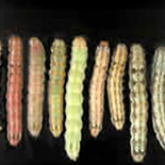Helicoverpa

Colour variations in helicoverpa larvae lucerne
© Queensland Government

H. punctigera (left) and H. armigera (right) larvae
© Queensland Government

Adult H. punctigera and H. armigera
© Queensland Government

Normal helicoverpa egg on left, black parasitised egg on right
© Queensland Government
Two species of helicoverpa are serious pests of field crops (particularly grain legumes, summer grains and cotton) in the northern grains region of Australia.
Helicoverpa armigera is generally regarded as the more serious pest because of its greater capacity to develop resistance to insecticides, broader host range, and persistence in cropping areas from year to year.
Scientific name
Helicoverpa punctigera (native budworm)
Other names
- Previously known as Heliothis
Description
Eggs
- 0.5mm in diameter
- change from white to brown to a black head stage before hatching
- parasitised eggs are mostly black.
Larvae
- newly hatched larvae are pale with tiny dark spots and dark heads
- medium larvae develop lines and bands running the length of the body and vary in colour
- armigera have a saddle of darker pigment on the fourth segment and at the back of the head and dark-coloured legs.
- punctigera have no saddle and light-coloured legs.
- large larvae of H. armigera have white hairs around the head; H. punctigera have black hairs around the head.
Pupae
- are found in soil underneath the crop
- wriggle violently when touched
- tail spines of H. armigera are more widely spaced than those of H. punctigera.
Moths
- dull light brown with dark markings
- 35mm long
- forewings are brown in the female, and cream in the male
- H. armigera has a small pale patch in the hindwing; the dark section is uniform in H. punctigera.
May be confused with
Armyworms, loopers
Distribution and habitat
Widespread across Australia.
H. punctigera numbers in cropping regions fluctuate based on conditions in inland breeding areas.
Hosts
The 2 species prefer different hosts:
- H. punctigera attacks broadleaf species (e.g. cotton, chickpea, sunflower, soybean, mungbean, navy bean, lucerne, canola, peanut, faba bean, safflower, linseed and azuki bean). It is not found on grass or cereal crops (e.g. wheat, barley, sorghum or maize).
- H. armigera will attack all field crops but is less common in wheat and barley.
Damage
- Larvae feed on leaves but are most damaging when feeding on growing terminals, buds or squares, flowers, pods, seed and/or fruit.
- Damage also occurs through bud/fruit shedding and reduced quality.
Life cycle
Development from egg to adult:
- 4–6 weeks in summer
- 8–12 weeks in spring or autumn
- final stage larvae drop from the plant and dig a pupal chamber
- moths live for about 10 days
- females lay about 1000 eggs
- in cold conditions, H. armigera pupae will diapause (hibernate).
Monitoring and thresholds
Eggs are most commonly laid on the top third of the plant and growing points.
Many crops can compensate for vegetative damage with minimal impact on yield. Closely monitor:
- very susceptible crops from emergence to maturity for eggs and larvae
- other crops from budding/flowering through to maturity.
Visit the Beatsheet for threshold calculators in chickpea and sorghum.
Natural enemies
- All stages of the helicoverpa life cycle are attacked by a wide range of predators and parasitoids.
- Conserve beneficials in the crop by avoiding broad-spectrum insecticides to help prevent/minimise the need for insecticide treatments.
- Formulations of pathogen-based insecticides are available commercially, including Bt (Bacillus thuringiensis) and NPV(nucleopolyhedrovirus).
Control
- Ensure you correctly identify the species present when you consider management options, as H. armigera has developed resistance to a wide range of insecticides.
- Products are available that reduce the impacts on natural enemies in the crop.
- Larvae are best targeted when smaller than 7mm.
- Biopesticides such as NPV work particularly well in crops with narrow flowering periods, such as sorghum.
- Attract-and-kill formulations such as Magnet® have been used in area-wide management programs to reduce populations.
- Pupae-busting (cultivation to 10cm at the end of the season) is used to disrupt the pupal stage of the life cycle.
- Several genetically modified crop varieties produce a natural toxin based on a bacteria that specifically targets caterpillar larvae—helicoverpa is not usually a problem in these crops.
Further information
- Helicoverpa: identification and behaviour—The Beatsheet
- Helicoverpa: management—The Beatsheet
- Economic threshold calculator for Helicoverpa—The Beatsheet
- Helicoverpa armigera—Cesar PestNotes
- Seasonal helicoverpa pheromone trapping—The Beatsheet
- Registered chemicals database—Australian Pesticides and Veterinary Medicines Authority (APVMA)
- Large numbers of helicoverpa moths in sunflowers (short video)—The Beatsheet
- Recognising helicoverpa infected with NPV in the field (video)—The Beatsheet